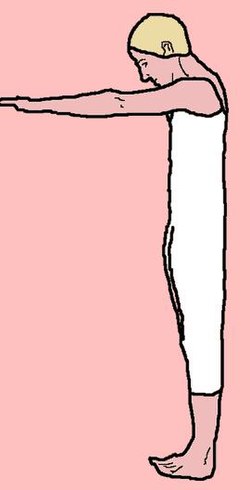Examination of position, gait and movements
Position[edit | edit source]
Active position: The patient manages to get himself into any position without assistance and without much effort
Passive position: The patient needs assistance to position himself
Obligatory position: The patient chooses a position that helps to alleviate their pain, such as the following:
- Orthopneic position: The patient has a sitting position with his head propped up (such as with pillows); associated with shortness of breath and cardiac condition
- Lying on his/her side: In the case of pleuritis, the patient lies on the affected side of the pleuritis - this helps to decrease the respiratory movements and the painful irritation caused by compression. In addition, the patient could also lie on the affected side when there is lung effusion - promoting the ventilation of the less affected lung
- Supine position: Usually associated with inflammation of the peritoneum
- Prone position on all extremities or on the stomach: Could be associated with pancreatic cancer - this position could help to alleviate pain
- Head turned backwards with flexion of the limbs (opistotonus): causes include meningitis, tetanus
Gait[edit | edit source]
We evaluate the posture when walking, walking speed and muscle weakness.
- Parkinson's gait: Small steps with anteflexion, bradykinesia, akinesia, dysskinesia.
- Ataxic gait: swaying and wobbly gait with a broad base (alcohol intoxication), cerebellar dysfunctions, tabes dorsalis , vestibular ataxia.
- Hemiplegic gait: The patient drags his affected leg when walking (circumduction) with foot drop due to weakness of the distal muscles. When standing, there is unilateral weakness on the affected side; arms tend to be flexed and internally rotated
- Diplegic gait (Spastic gait): The spastic limb is stiff, difficult to flex. When walking, the patient has an unusual narrow base and drags both legs. There is tightness of hip adductors that could result in the "scissors gait" - legs crossing in the midline
- Waddling gait: "Duck like walk" - the patient walks with an exaggerated waddling movement; weakness of the hip girdle muscles that could be unilateral (drop of pelvis on the contralateral side) or bilateral (drop of pelvis on both sides); could be caused by progressive muscular dystrophy
Romberg test[edit | edit source]
- The Romberg test could be used to assess the patient's sense of balance, involving the proprioception (also the function of the dorsal column). The steps are as follows:
- The patient is requested to remove his shoes and stand with his two feet together. The arms are positioned next to the body or crossed in front of the body.
- He is then asked to first stand quietly with eyes open, and later with eyes closed. The patient tries to maintain his balance. For safety, it is essential that the observer stand close to the patient to prevent potential injury if the patient were to fall. When the patients closes his eyes, he should not orient himself by light, sense or sound, as this could influence the test result and cause a false positive outcome.
- The Romberg test is evaluated by counting the seconds the patient is able to stand with eyes closed.
Abnormal Muscle movements[edit | edit source]
- Abnormal movements include:
- Tic: Uncontrolled movements of a group of muscles predominant in stressful situations and disappearing in sleep.
- Tremor: Involuntary rhythmic movement affecting limbs, head, eyelids; disappears in sleep; could be present in:
- Parkinson's disease - "Parkinsonian tremor" rhythmic shaking of the hands
- In thyrotoxicosis: Fine and not clearly visible tremor, could be better evaluated by palpation
- In neurotics: More apparent tremor than that in thyrotoxicosis
- Convulsion: Involuntary contraction and spasm of muscles that lead to irregular and sudden movements of the body; could be associated to epilepsy (with convulsions apparent on the limbs and head, along with loss of consciousness)



